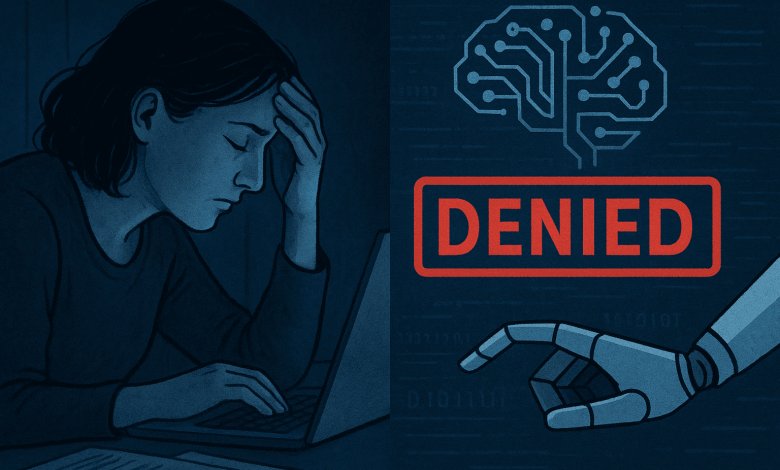
When AI Denied My Wife’s Cancer Treatment
The letter arrived while my wife was in the middle of chemotherapy. Her insurance company had denied coverage for a cancer drug her oncologist had prescribed – not because the drug wouldn’t work, not because it wasn’t medically necessary, but because an algorithm had processed her claim in less than two seconds and spit out a denial. I spent the next eight hours researching insurance codes, combing through policy documents, and crafting an appeal letter when I should have been supporting my wife through treatment.
When I finally submitted the appeal, the denial was overturned within days. The drug had been covered all along. That experience taught me something troubling: health insurers denied nearly one out of every five claims for in-network services in 2023, yet fewer than 1% of denied claims are ever appealed. The math is damning – insurance companies are systematically denying valid claims, betting that patients are too exhausted, too intimidated, or too sick to fight back.
The Rise of Automated Denial Systems
What was once a bureaucratic inconvenience has become an automated denial machine. Over 60% of physicians now report that unregulated AI tools systematically deny patients coverage for necessary care. Medicare Advantage plans have been investigated for using algorithms to deny claims, calculating which patients were least likely to appeal. Cigna Healthcare allegedly refused 300,000 pre-approved claims, denying them in less than 2 seconds on average.
These aren’t occasional errors, they’re features of a system designed to maximize profits by minimizing payouts. As a healthcare researcher leading NIH-funded studies on AI and caregiving, I recognized we were witnessing an arms race where only one side had weapons. Insurance companies had deployed sophisticated AI to deny claims at scale, while patients were left with phone trees, byzantine appeals processes, and the requirement to become amateur medical-legal experts while managing serious illness.
Building AI for Patients, Not Profits
The solution became clear: if insurance companies were using AI to deny care, patients needed AI to fight back. We built a platform that operates on a simple principle – patients upload their denial letter and insurance policy, and AI generates a comprehensive, medically-cited appeal letter in under two minutes. The system was trained on tens of thousands of successful appeals, independent medical reviews from state insurance commissions, and legal filings from lawsuits against insurers.
The result is a tool that levels the playing field, fighting algorithms with algorithms. Since launching in January 2025, thousands of patients and several clinics have used the platform, achieving success rates exceeding 70%, significantly better than baseline appeals. One rheumatology clinic administrator told us she now gets approvals back the same day or next day, where previously she’d spend hours per appeal.
Real Patients, Real Results
An Illinois woman used the platform to overturn a denial for a cancerous tumor removal and won back $40,000. A Bay Area mother successfully challenged a $2,000 maternity bill that had been improperly denied years after her child was born. A Philadelphia woman overturned a denial for ADHD medication she’d relied on for over a decade. These victories matter because they represent more than overturned claims, they represent a fundamental question about the role of AI in healthcare: whose interests does the technology serve?
The Regulatory Response Falls Short
California recently passed landmark legislation requiring that any denial based on medical necessity must be reviewed by a licensed physician, recognizing that algorithms cannot replace human judgment. But regulation alone isn’t enough. We need technology built explicitly for patients – freely available, transparent, and designed to restore balance to a system that has tilted dangerously toward corporate interests.
The business model of modern health insurance increasingly relies on the exhaustion of sick people. 45% of insured adults reported receiving unexpected medical bills for services they thought were covered, and nearly 15% of medical claims submitted to private insurers are initially denied. This represents roughly $1 trillion in denied claims annually—and an untold toll in delayed care, foregone treatment, and families pushed into medical bankruptcy.
Making Healthcare Advocacy Accessible
The platform remains free to patients because healthcare advocacy shouldn’t be a luxury good. It’s funded through grants and designed to scale, each appeal costs pennies to generate. The goal isn’t to build a profitable company, but to fundamentally shift the economics of denials. If fighting back becomes easy enough, insurers will have to think twice before deploying automated denial systems.
The Future of AI in Healthcare
My wife survived her cancer. But I’ll never forget those hours I spent fighting her insurance company when I should have been with her. No family should face that choice. Technology created this problem – insurers weaponizing AI to deny care at scale with minimal human oversight. Technology can help solve it, but only if we’re deliberate about whose side we’re on.
The question isn’t whether AI will transform healthcare, it already has. The question is whether that transformation serves patients or profits. When algorithms can deny coverage in seconds but patients must spend hours or days fighting back, the imbalance is clear. The future of AI in healthcare depends on building tools that empower patients, not just insurance companies.
This is the real AI revolution in healthcare: not chatbots or diagnostic tools, but systems that restore equity when power imbalances threaten patient care. As AI becomes more sophisticated, we must ensure it amplifies patient voices rather than silencing them. The technology exists. The only question is whether we’ll use it for the right purpose.




